|
Monday, September 26, 2011
Progress Notes
The last few years have seen our country undergo tough economic times which some say may be the most severe since the Great Depression of the late 1920’s and 1930’s. I have given some thought recently to how those who lived through the Great Depression survived considering that the incomes then were so much lower and few people had enough money even without having to endure a severe economic downturn.
Recently, I came across an autobiography in our museum library written by Sophie Wilson Hill, now deceased, who told of her childhood and early adult experiences during the great depression. The way her generation survived when cars were few, stores far away, and farming methods were laborious without mechanization seems to have been based to a great extent on a different attitude toward life than what we observe today. In this area, farming by far was the most common means of providing for oneself. It seems that self reliance and an exceptional work ethic were the most critical assets because in those earlier days government was small and far away, the later economic programs of the 1930’s depression not being available.
Sophie’s story begins with her grandfather, Dr. Thomas Benson Wilson in Aurora Springs, Missouri, and then detours through Kansas and Oklahoma before returning to Missouri:
Milestones of the Past
Sophie Wilson Hill
1996
Born:
1 Sept. 1911
Died:
10 Apr. 2002
w/o John Hill
Wed 10 June 1931
Helen Schulte suggested that I write a little history of events, that I related to her when we met one day at the Miller County Museum in Tuscumbia.
The following narrative is about events, past and present, that happened in the lives of my pioneer ancestors, of my own life, and of my family. They are written from my own memories, and some as told by my parents.
The Early Years
My story begins in the late 1800’s. My grandfather, Dr. Thomas Benton Wilson, was a physician (photo 01).

01 Dr. Thomas Benton Wilson
When a young man, he was graduated from a medical academy in Illinois or Indiana; the documents have been lost over the years. He then started his medical practice in a city in Illinois (I believe Centralia). Later he and his family moved to Zenia, Illinois, where my father, Ralph Wilson, was born August 4, 1866.
When my father was about 16 years of age the doctor moved his family to Aurora Springs, Missouri, approximately in the year 1882. He built a new home there. At this time, there was a “mad” rush to Aurora Springs because of the mineral springs which were supposed to have great health giving properties. Many doctors came also, but in a short time the mineral waters attraction began to fade out and people left. My grandparents lived there for about a year or maybe two and then, they also left. At one time Aurora Springs was a thriving town until the railroad came to Eldon. Then, it is said, businesses, home building and general growth went to Eldon, Missouri.
Note: you can read about Aurora Springs at this previous Progress Notes.
My grandfather and his family moved to Lawrence, Kansas, where he resumed his medical practice; by this time my father was a young man. He worked at this and that; at one time he sold nursery stock and owned his own nursery, selling mostly fruit trees. He also owned a small store that contributed to his income; but the spirit of adventure was urging him to see new places and try new things (photo 02).
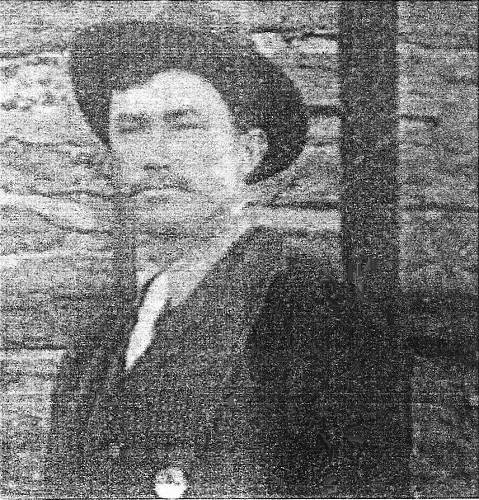
02 Ralph Wilson, Father of Sophie - Age 33 - 1899
He and an older man decided they wanted to look at land in Colorado. They out fitted a wagon with supplies and started on their trip, this was about the year 1887. When about halfway out the older man decided to turn back, so my father continued on with a few necessary provisions in a light pack and a 38 caliber revolver for protection. That is a story in itself which I will only touch on here.
The railroad was being built out through Colorado at this time, so he followed this, which led him to the “old Stone Ranch” that had once been a “stronghold” and the scene of range wars and Indian skirmishes, but was being used at this time for headquarters for a cattle roundup (photo 03).

03 Old Ranch
Here he met Jesse Johns, one of “Teddy” Roosevelt’s “Rough Riders,” who at this time was range boss with a group of cowboys who were rounding up cattle, branding them, etc., getting ready for the drive. My father spent the night and rested a while, ate sour dough biscuits, bacon and coffee, and listened to the cowboys’ colorful tales.
Jesse Johns told him if he was interested in land, he would suggest that he return home and wait for the land grants n the Oklahoma Territory, which the government was to open to the public in the near future. This was a presidential election year, the year Benjamin Harrison was elected president. Father was 21 years old and anxious to cast his first vote, so he returned home, but he kept his dream of homesteading when the Territory was opened to the public. In the meantime, my father talked his parents into joining him in this pioneer venture.
My grandfather was wanting to retire from medical practice, so he thought this might be an opportunity to get away from his patients, who kept coming to him for treatment although he had announced his retirement, he was a good doctor and it was hard to turn them down. It was a funny coincidence that later after the new land was settled, many of his former patients had discovered their old doctor out here and called on him again for his services. He began his medical career all over again because of the need and scarcity of doctors. A book could have been written on his experiences as a frontier doctor; it was quite different from being a city doctor back home, he had a wide practice until he was too old to work anymore.
One experience he had was being caught in a blizzard while making a call on a patient miles from home. He was too far out to turn back for home, and too far from the patient to go on in a blizzard, so he tied his horse to the back of the buggy, put a nose bag of feed over the horse’s head, then wrapped himself in his buffalo robe that he always took with him and laid down against a drift fence to weather the storm,. When the storm passed he hitched his horse to the buggy and proceeded on his way.
To get back to the earlier part of my story…In the year 1893 my father and grandfather prepared to go and enter the race for land, each a quarter section, 160 acres. They signed up at the Land Office, and they were there with thousands of others, awaiting the moment when the signal would be given for the race to begin. At noon September 16, 1893, a shot rang out that started the race for land; more than 100,000 settlers raced for 42,000 claims. By sunset there would be tent cities, and endless lines of people lined up at the land offices. The Cherokee Strip run was an exciting finale to what many called the last American Frontier.
Note: from Wikipedia:
The Cherokee Outlet, often mistakenly referred to as the Cherokee Strip, was located in what is now the state of Oklahoma, in the United States. It was a sixty-mile (97 km) wide strip of land south of the Oklahoma-Kansas border between the 96th and 100th meridians. It was about 225 miles (362 km) long and in 1891 contained 8,144,682.91 acres (32,960 km²). Enid and Woodward fall within the historical boundaries of the Cherokee Outlet.
The Cherokee Strip was a two-mile strip running along the northern border of much of the Cherokee Outlet, and it was the result of a surveying error.
My father and my grandfather took claims adjoining each other. They made temporary living quarters until better houses could be built. My grandfather and grandmother Wilson’s first home was a log cabin, crude, but comfortable
Note: See the lace curtains at the window of the door in photo 09 below.
Some of her nice things she had brought with her from her former home. They lived in this for a while, then built a nice two story frame house with a veranda (photo 06).
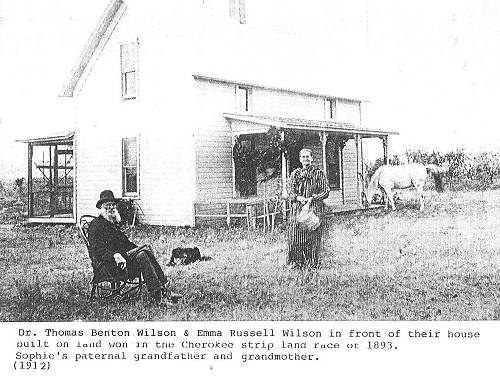
06 Dr. Wilson Home at Cherokee Strip Land Race - 1912
Click image for larger view
This was only the beginning of the settler’s trials taming this wild harsh land. It would take too much space here to relate the hardships; the encounters with climate, epidemics, lack of conveniences, and even necessities, that they had been accustomed to in the homes they left behind. The Pioneer people must face these, and find strength to go ahead against the odds. They built homes and farms, battled against the harsh winters, the heat, dust, winds of summer, and the tornadoes that were typical of Oklahoma.
Above the hardships there was a great challenge and fulfillment for those who struggled and prevailed. Many settlers built solid homes, fine farms, and finally came to enjoy some of the comforts of life they had worked for. Others became discouraged, sold their claims, and returned to the homes they had left.
The house my grandparents built is still standing, and had been recently occupied when my daughter Shirley and went to Oklahoma in 1993 to attend the 100 year Centennial Celebration of the Oklahoma land run of 1893. It was a great event. My son, Clifford, my brother Mark Wilson, my daughter Shirley, and I went back a little later and visited the home of our grandparents. Mark is 87 years old and could remember visiting our grandparents in that house. We also walked on the place where we were born. Grandfather’s house needed paint but stood sturdy and strong.
My father’s first home was a dugout into a bank or rise in the ground, then shored up on the inside with logs or lumber for walls and ceiling. He had the bare necessities for living, a bed, stove, table, bench and shelves. The outside was covered with thick blocks of sod; they were primitive homes, but served well for first homes for many settlers. They were warm in winter, and cool in summer. Now and then a snake, lizard, or mouse might get in and want to share this humble abode, but the pioneer soon learned how to deal with these little emergencies.
There were still signs of the buffalo: the wallows and the dried dung which the settlers called buffalo chips. When fuel was scarce, this was often burned for fuel which made a hot fire.
Now it was time to go back to the old home in Burlingame, Kansas to get grandmother, finalize any business that had to be taken care of before permanently leaving, and make preparations for the journey to the new home in Oklahoma. They made ready the covered wagon with all the supplies they could carry, the chuck wagon full of food and utensils to camp along the way, and the usual water barrel.
On Thanksgiving Day, the year 1893, a beautiful balmy Indian summer day, they left their home in Burlingame, Kansas, and started on the long journey to their new home. They were well prepared for the trip, but were not prepared for the blizzard that they ran into on the first day out. My father had a good team of horses so they made good time. When they had traveled away out in the middle of uncharted prairie, the wind suddenly changed to freezing cold. Snow and sleet carried by a whirling bitterly cold wind whipped the faces of the drivers with such intense fury it was impossible for them to see where they were going. They were caught in a blizzard. My father told my grandfather who was getting up in years to join my grandmother in the shelter of the wagon who was already between two feather beds and quilts, to try to keep from freezing. My father climbed down from the driver’s seat and started the team at a lively trot and trotted along beside the wagon to keep his blood circulating so, hopefully, he would not freeze. He had no idea where he was going in the denseness of the blizzard. Darkness was coming on early because of the storm, but he knew he must keep moving or he and all would perish.
Finally, through the whirling snow and ice he saw a dim light; it was impossible to tell how far away it was. It was just a foggy glow in the darkness and storm, but it was a beacon of hope to the freezing man. Where there was light, there must be human habitation. As he drove toward the light, he was almost upon it before he realized it. The light came from a single window or door; he could see nothing else, not even the bulk of the building. He took a tether rope and fastened it to the wagon wheel, and the other end to his hand; he knew one could easily get lost in a storm like this and wander away in the wrong direction. He felt his way toward the light and his hand came up against the wall of the building. He felt his way to the door from which the light came, he knocked and no one answered. He knocked again, and finally a man opened a small crack of the door. My father explained the situation, that his mother and father were in the wagon, and he was afraid they would all freeze in this terrible storm. He begged that they might stay the night there and told him they had their own provisions and asked only for shelter form the storm. Finally, the man reluctantly agreed to let them stay for the night, and told my father about a shed where he could put the horses. After he helped his other and father to shelter and a few necessary things for food and bed, he took care of his team of horses and fed them generously. He came in and settled for the night while the storm raged outside. Their host didn’t have much to say, but the warmth of the big fireplace which warmed the large room made up for the aloofness of their benefactor.
When morning came the storm had passed. The sun was shining on a vast expanse of deep snow. The travelers ate their breakfast, fed the horses, and put their belongings back in the wagon. They thanked their host for his hospitality, and started again on their journey. It was still bitter cold, but they were dressed warmly and now they could see where they were going. Although the sun shining on the unending miles of snow was almost blinding, they were still able to get sense of direction.
Later, they were told that the man that they had spent the night with was a fugitive from the law. He had killed a man in Texas; he was hiding here in this out of the way place in the hope that he would not be found, which was the reason for his reluctance about letting the travelers in; but my father and my grandparents felt that it was a “God send” that he was there and gave them shelter from the storm.
After traveling and making camp many days and nights they finally reached their destination. My father and my grandfather had staked claims adjoining each other. It was too late in the season to break fields and plant, so the settlers built fences and prepared for the coming year. The farmers needed special sod plows to break the prairie sod which had never been plowed. The pioneers called these “sod busters.”
In the next few years, crops were planted… mostly wheat and some corn. Farmers began to accumulate better farm machinery and livestock. They raised cattle, horses and hogs; also poultry. The farmer in those early years needed to be self supporting, so they raised most of their food.
My father spent the first few years in his “dugout” home while working and improving his claim. But soon people began to get acquainted and communicate with their neighbors. School houses and churches were built. In rural communities the one room school house was the gathering place for farm families and often served as a house of worship on Sunday. During this time my father met my mother, Miss Laura Gertrude McGill, whose father had also homesteaded not many miles from my father’s claim. Here their romance began.
My grandfather McGill had come from Missouri to take part in the race for land in 1893. My mother was born in Green County, Missouri, near Cave Springs on August 24, 1877. My grandfather came ahead and built a large sod home, then, went back and brought his family to the new claim.
My mother has often described this sod home to her children. She loved it. The grass side was outside and the dirt on the inside was wet and troweled down many times to make it hard packed; when dry both walls and floors were hard a s brick. These were then white washed with gypsum which was native in the soil in Oklahoma in places. The dictionary describes it as a mineral that is used in plaster of Paris. My mother mixed this with water and painted the walls and ceiling hardened into a smooth blue white finish which she said was beautiful. Her grandmother who lived with the family loomed carpets and the hardened dirt floors were covered with straw or prairie grass and then the carpets were stretched and pegged down around the edges. At her request her father made a window seat of lumber in the living room where big double windows graced the wall next to the hillside. Here my mother, a young girl of eighteen years, the eldest of a family of six children, put little crafts, pictures, and handmade cushions to the “pretty up” the room. She wanted to be married in this sod home, but a new house was built and there she was married.
My father and mother’s romance progressed and they were married February 21, 1898 (photo 07).
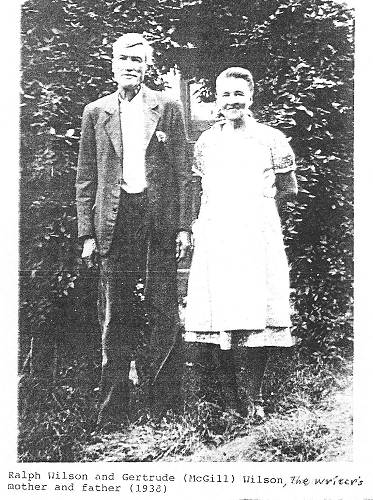
07 Ralph and Gertrude Wilson, Parents of Sophie
Click image for larger view
By this time my father had built a frame house and made improvements around the home site. He had planted a young orchard and wind breaks to protect the home from the harsh winds of winter and provide shade for summer. He had been farming his land, “proving up” and had secured his ownership from the government and the farm was his. Here he brought his bride. In their prairie home a large family was born. We lived here until about the year of 1914, and then moved to Lawrence, Kansas. My father rented his property in Oklahoma. Oklahoma began to be plagued with hot winds that came just a while before the wheat was ready to harvest, which withered the crop, and was a great loss to the farmers. Also, the coming of the farmer’s plow seemed to release the soil that had once been sod, and dust storms followed. These were on the smaller scale, but probably forerunners of the great dust storms of the 1930’s and 40’s.
My parents wanted their children to have educational opportunities, so they settled in Lawrence, Kansas that was regarded as a school town. This was in the year 1914. Here, the older children went to school. We lived in Lawrence, about three years, then moved to Kansas City, Kansas where we lived about one year. My father was looking for a farm, and bought a 200 acre farm near Bagnell, Missouri.
Home In The Ozark Hills
My parents began making plans for our move to our new home in Missouri. My father thought it would be fun to play pioneer once again, so he bought a wagon and a good team of horses. He bought canvas and bows for the covered wagon; he built an over jet which was wider than the wagon bed, and was clamped on to the wagon bed and the bows were secured to this. This made more room inside the wagon. We could have come on the train, but this would by more fun!
In April of 1918 we started on our trip from Kansas City, Kansas to our home in Missouri. Our next door neighbors, Mr. Gunn and family came over and saw us off. He gave us a railroad lantern to hang on our wagon if we traveled at night or if we needed a camp light. He was a railroad man. Their little daughter, Edith, who was about my age, and I were inseparable friends and we cried many tears at our parting.
This was quite an adventure for us younger children and to us it was a wonderful time. My mother cooked meals on a little camp stove over a small camp fire and we ate outside the wagon; everything tasted great. It took us a week to make the trip from Kansas City to our new home. We were lucky that the weather was nice the whole way. We had to camp for a couple of days and nights when our father got sick with pneumonia. Mother “doctored” him with home remedies and in a couple of days we were on the road again.
The roads were unpaved, dirt roads all the way except through towns. Once we had to drive off to the side of the road and wait for a large herd of cattle to pass. They were driven by men on horses, who were probably driving them to some railroad shipping place.
I will always remember how nice and friendly people were to us along the way. If we camped where we were in sight of a house, my father always went and asked permission to camp there; everyone always made us feel welcome. One place a man and a woman brought a big pot of stew which added to the supper that our mother had made and was a great meal for hungry travelers. They stayed and visited a little while before gong back to their house. As we traveled down the road a few miles from our new home, we saw a little boy who looked to be 3 or 4 years old, he was standing by a fence by the roadside crying. My father stopped and asked him why he was crying. He said, “I am lost.” He said his name was Leonard Heafy. My father picked him up in the wagon, and just around the curve we saw a white farm house. The little boy said, “That is my house.” Sure enough, he belonged there. He was just around the corner from home, but he felt very lost (photo 07a).
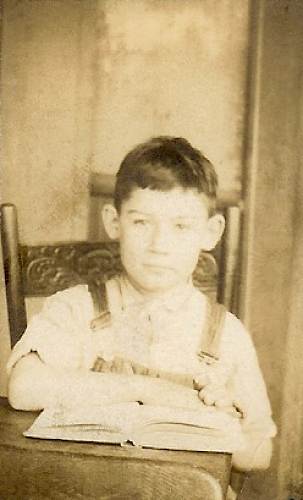
07a Leonard Heafy
As we traveled on down the road, we saw a young man and a boy cutting and piling brush by the roadside. My father stopped to ask directions. The young man was Oscar Hill, the boy, John Hill. He (John) didn’t know then that the little girl peeking out of the back of the wagon would be his future wife: I was six years old then, that was a story yet untold.
April 8th, 1918, we drove into the yard of our new home. We were tired but happy; we were home! We children were running every where, eager to see everything about our new home. It was a very plain farm house but it was ours. It didn’t take long for the house to become a home (photos 08 - 11).
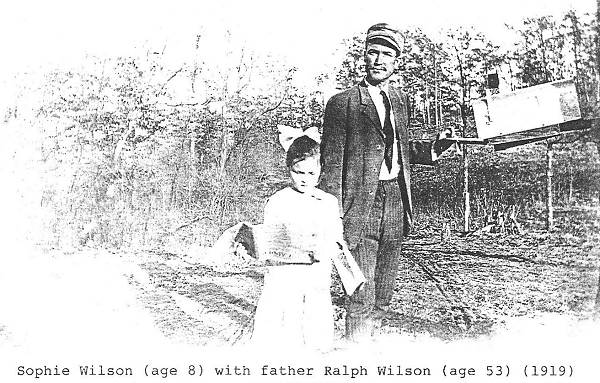
08 Sophie and her father Ralph Wilson - 1919
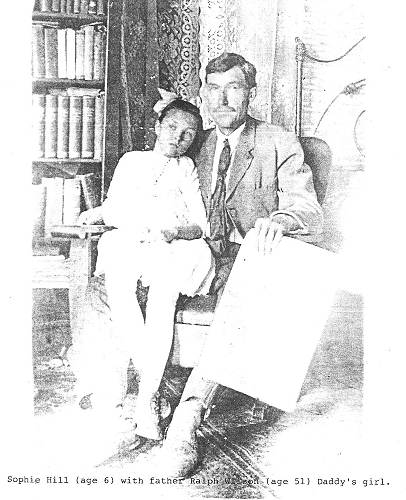
09 Sophie with father Ralph Wilson - 1917
Click image for larger view
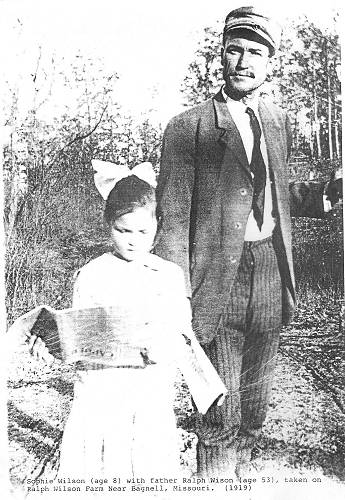
10 Sophie Wilson with father Ralph Wilson on farm near Bagnell - 1919
Click image for larger view
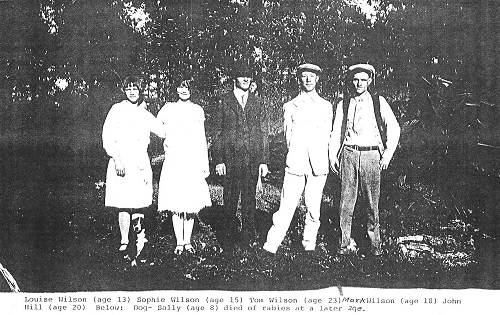
11 Sophie and siblings with John Hill
Click image for larger view
I was next to the youngest of seven children. My little sister, Louise, four years old, two older sisters, Daphne and Emma; one little sister, Kathryn or Katie, as we called her, died the first year we came to Missouri; two older brothers, Tom and Marcus (Mark, for short). Mark, Louise and I started school in a one room rural school house named Harmony. Our first teacher was Mr. Charley Snodgrass (photo 12).
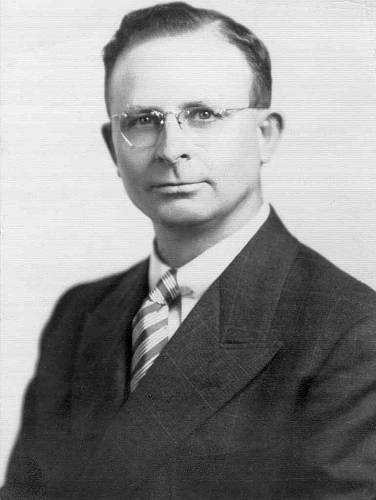
12 C.D. Snodgrass
The children always looked forward to his visiting our school. Oh, the memories of old Harmony School! I think I could write a book about our old rural school.
My family lived in our new home with its orchards, fields and woodlands until each of us children grew up, married and left the home nest.
Old Bagnell Before the Dam
Bagnell was the town nearest our home where we did most of our buying….a country hamlet where everyone knew everyone else. Where grown men would draw a ring in the dust beside the street and shoot a game of marbles on a Saturday afternoon, or have a game of “mumbly peg” with their jack knives, or sit on the porch of a store and play checkers. In some ways it was a rough town. Sometimes there were fights and drinking on Saturday nights after a payday, but, all in all, it was a busy, lively and productive little rural town. There were several stores, a high school, a grade school and churches. The Missouri Pacific railroad terminal was here where the trains changed tracks on the turn table at the round house. All the activity was interesting to me (photos 13 - 17).
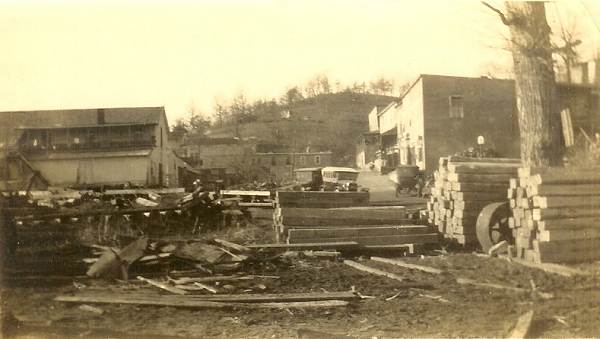
13 Old Bagnell
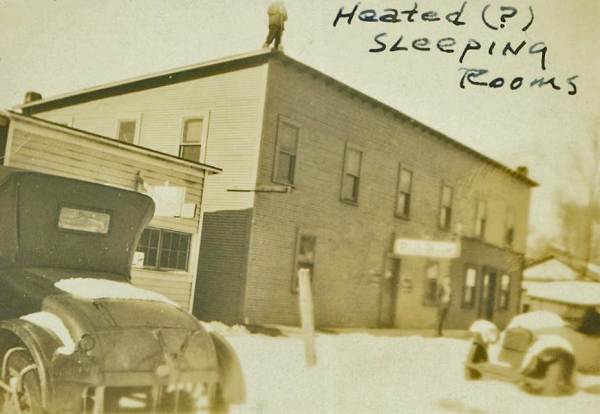
14 Pool Hall and Sleeping Rooms - Jan 1930
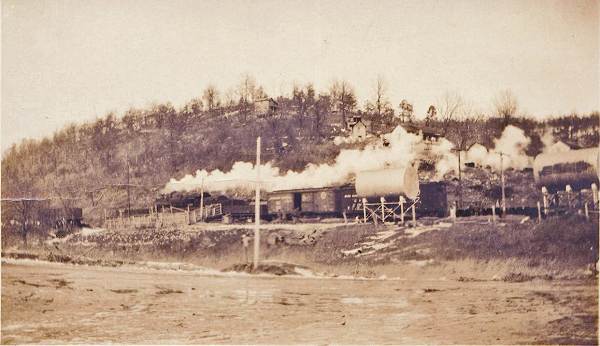
15 Missouri Pacific Train leaving Bagnell
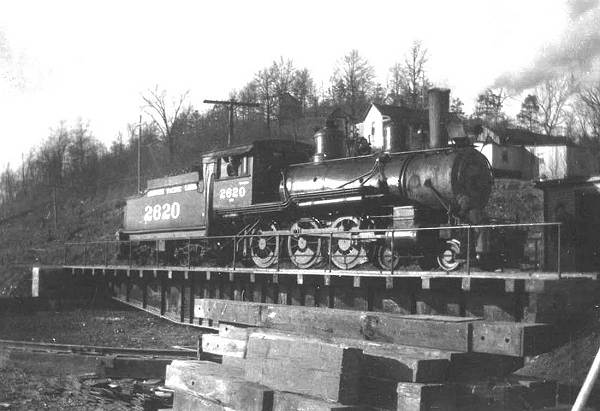
16 Missouri Pacific Railroad Bagnell Branch Turnaround
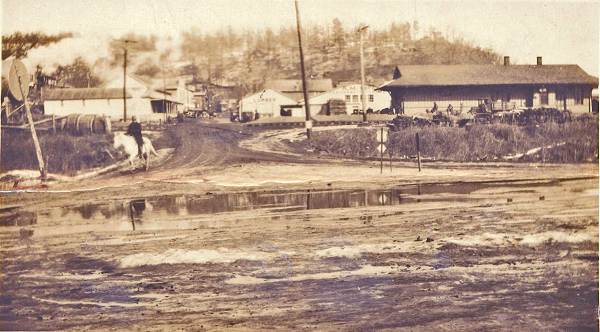
17 Old Bagnell Train Station on Right
I remember, when I was a little girl, going to Bagnell with my parents. Sometimes I would beg them to let me sit in the wagon while they did their buying. My father tied the team of horses to the “hitching rail,” and I sat and watched the tie loaders carry the ties on their shoulders as they walked the springboard. The men had heavy pads on their shoulders to protect them from the heavy railroad ties. When they lifted the tie on their shoulder they kept it rolling and bouncing lightly with the motion of the springboard that led to the flat car. When they reached the flat car they bounced the heavy tie off their shoulder in exactly the right place. It was fascinating to watch them work, every motion in unison. At this time, Bagnell was known as the tie capital of the world. More ties were handled and sent from here than any place in the world (photo 18).

18 Bagnell Tie Yard
I also loved to watch the ferryboat plying back and forth across the Osage River that ran by the town, carrying passengers, even horses and wagons (photo 19).
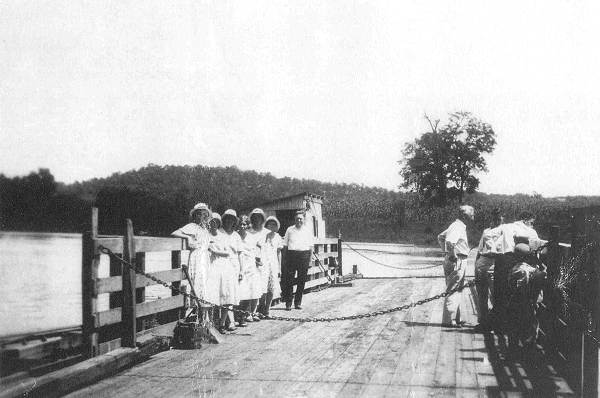
19 Bagnell Ferry
But unknown then to the town and surrounding communities, a great project was being planned that would change this prosperous little town of Bagnell and surrounding communities forever.
The Construction of Bagnell Dam
This great project had been in the planning stage for several years before work actually began. In the year 1928 the news was out that work at the dam site had started and they were hiring workers. I think Stone and Webster was the company that started work on the construction; later, Union Electric Light and Power Company took it over. There was a mad rush to be there for the hiring, and not only local people, but people from all over the United States and some from other countries came looking for work. It was the beginning of the depression and jobs were scarce. The town of Bagnell, close to the construction site, became a bee hive of excitement. People were streaming in from all over looking for a place to stay while they worked. Some from afar brought their families. Every available hotel or room was filled in both Bagnell and Eldon, so housing had to be provided for many. Carpenters were put to work building house near the work site for those who needed a place to stay.
My older sisters, Daphne and Emma, were married by now, and I was “keeping company” with a fine young man named John Hill, a brother to my sister Emma’s husband (Oscar Hill). Our first date was at a neighbor’s home (Charley Allen), where the young people of the neighborhood had gathered for a music party and games which were popular in those days. Entertainment was more home spun back then, at least in rural communities.
Both of my brothers, Tom and Mark, and my “boy friend,” John Hill were hired at the dam construction and worked almost all the way through until it was completed.
On a beautiful day, June 10, 1931, John and I were married. We were very happy (photo 20).
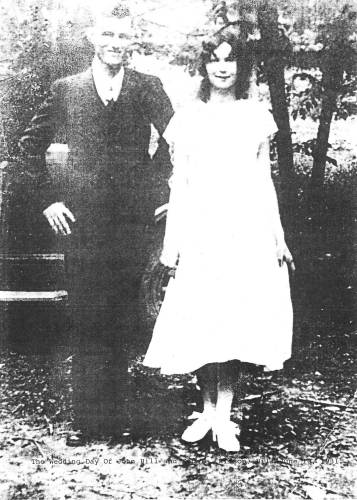
20 John and Sophie Wilson Hill Wedding Photo
After the dam was finished and most of the workers were gone, buildings at the site were being sold since there was no longer use for them. John bought one of these and had it moved to the back of his father’s farm. It was set in a lovely little grassy valley with two big walnut trees in our yard. It was a small house but was built for convenience; it had “built in” cabinets, shelves and a large closet. When we arranged our furniture, put up bright curtains, and hung pictures on the walls, it was all we needed for our first little home. Here our first baby was born, June 18, 1935, a beautiful baby boy we named Stanley Wayne. Now we were a family, even though times were hard. We were very happy (photo 21).

21 John and Sophie Hill with children on Jesse Hill Farm
Click image for larger view
The Great Depression
During the 30’s and early 40’s, the Great Depression came and with it a drought. There were hardly any jobs to be found anywhere, city or country. Pastures dried up for lack of rain, creeks and ponds went dry in many places, and some farmers had to feed hay to their live stock, even in summer. We were lucky to have a wonderful spring that never changed in its volume even in dry weather. The spring branch flowed into a creek. Two of our neighbors watered their animals from the water that ran from this spring.
The depression years were hard for everyone but I think most country folk fared better than many who lived in the cities. People who depended entirely on their jobs were in a desperate situation, for there were no jobs or very few. Many lost their homes; when they lost their jobs, they could not pay their rent or taxes or payments.
Most country folks had a cow for mild and butter, chickens for meat and eggs, and if you were lucky a hog to butcher, if you could manage to have feed to fatten it. If you had cream or eggs you could sell them at your local store for a little extra money. Or if you had plenty of chickens, you could grab a few, tie their legs together and sell them at your store or poultry house. But that was a long time ago, a different era of time.
Many things were rationed at this time. We were engaged in World War II during the early 40’s and ration books with stamps were issued by the government for sugar, coffee, lard and some other items that were needed for war purposes. A funny incident happened with our neighbors, John and Ada Sears. John always got up early to do his chores before Ada got up. He thought he would get the coffee pot ready to perk when Ada got up to get breakfast. He emptied the old “grounds” in the ash can and put the last of their rationed coffee in the percolator cup. When Ada sleepily went to the kitchen, she emptied the last of their coffee into the ash can, thinking it was old used coffee. When John came in from the chores he said, “Where is the coffee?” She said, “There isn’t any,” of course, then it was explained what happened, and as both felt they had to have their coffee, they got in their car and came down to our house for a cup of coffee. When they told what happened, we all had a big laugh and as we were just sitting down to breakfast, we invited them to have breakfast with us. We didn’t use as much coffee as they did and had a little surplus which we gave them when they left for home. You would have thought John had received a pot of gold! They did not use as much sugar as we did, so they traded some of their sugar stamps to us for some of our coffee stamps. Neighbors helped each other in those hard depression years.
Circumstances and time change things. We lived in the “Little House” until Dad Hill passed away December 1, 1935. Mother Hill was alone now and she wanted to stay in her home, but she was getting old and not well, so we sold our little house and moved into the dear old log house with John’s mother, where we lived ten happy years.
Shirley, Clifford, and Richard were all born here in the same house where their father was born. Now we had four lovely, lively children; we were a happy family. In the year 1942, October 14, my father passed away and my mother came to live with us, so for a short time our children had two grandmothers in their lives. In May, 1945, Mother Hill passed away, and in September of the same year we traded places with the Sears family, and we moved from the old Hill homestead where we spent many happy years, and started our lives in the home here near Tuscumbia, where we have lived for more than 50 years. It was a good move, close to John’s work for a while at Anchor Milling Company, later at Pryor Novelty Company. Also, we were close to the schools where all our children went.
And soon this became home, and we got acquainted with the neighborly people of Tuscumbia, and found many dear friends through the years. This has been home to me longer than any place I have lived. My mother lived with us until her death, December 19, 1956 (photos 22, 23 and 24).
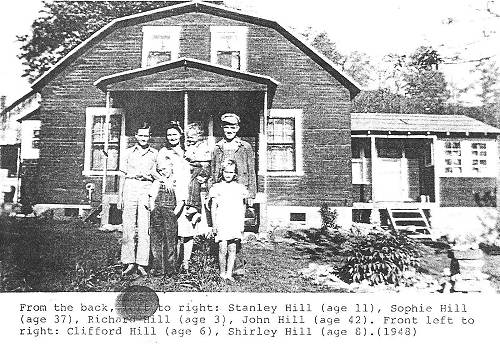
22 Hill Family at Tuscumbia Farm
Click image for larger view
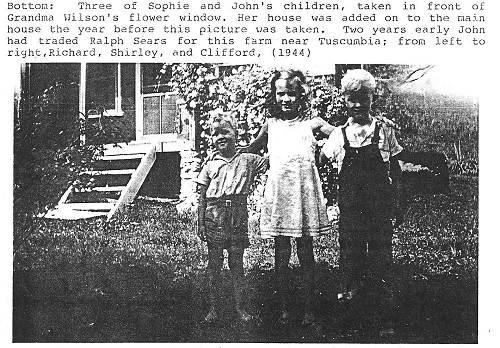
23 Richard, Shirley and Clifford Hill at Farm Home near Tuscumbia
Click image for larger view
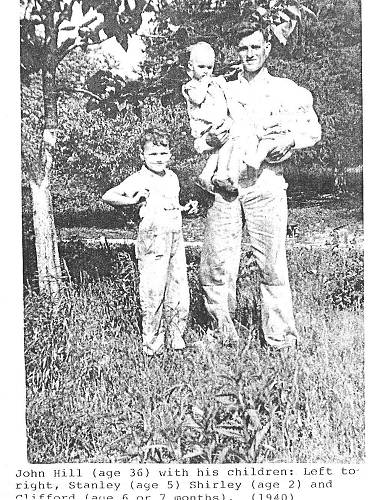
24 John Hill with children Stanley, Shirley and Clifford
Click image for larger view
I am alone now since John’s death, June 20, 1992. We were married 61 years. He passed away at Still Hospital ten days after our Wedding Anniversary June 10. They were happy years with the trials and triumphs of a long married life together. Our children are all married and gone, but come home as often as possible, and the old home still rings with joyful voices when we get together for the holidays now and then. The old table groans with its load of goodies that we have all put together for the feast and, as we got to God in thankful prayer, we can feel the spirit of those who are no longer with us.
This brings to a close my sketchy narrative from the 1800’s to the present, 1996. My intention was only to write some of the highlights between that time and the present. I have written some memoirs more in detail which will be in book form some time in the future.
John Hill’s father was Jesse Hill; here is a photo of Jesse’s family before John was added to the family (photo 25).
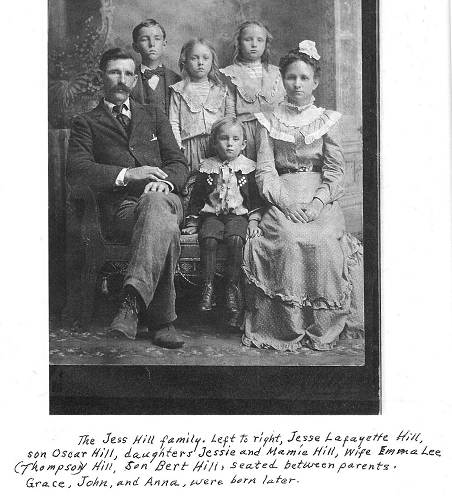
25 Jess Hill Family
Click image for larger view
Jesse’s father was a Civil War veteran named Robert Field Hill (photo 26).
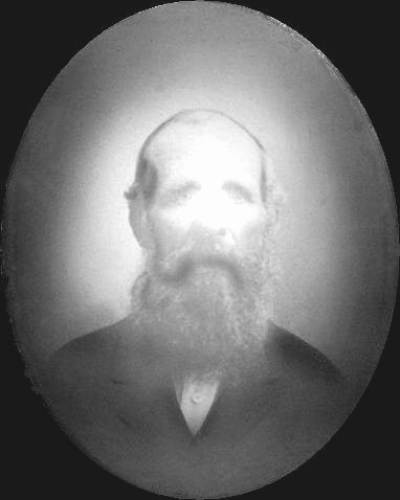
26 Robert Field Hill, Civil War Veteran and Grandfather of John Hill
I knew the Hill family well since the farm they moved to in Tuscumbia was down in a valley just below my home on top of a hill overlooking Shut In Creek. I remember going to their home often when Sophie’s mother lived with them. Sophie was a talented artist and musician. She played the guitar and sang very well. All the children seemed to inherit her artistic gifts in one way or another. Over the years, Clifford, who is about three or four years older than I, has become quite well known locally as a talented fiddle player. He has played with the Joe Jeffries band at our museum often (photos 27 and 28).
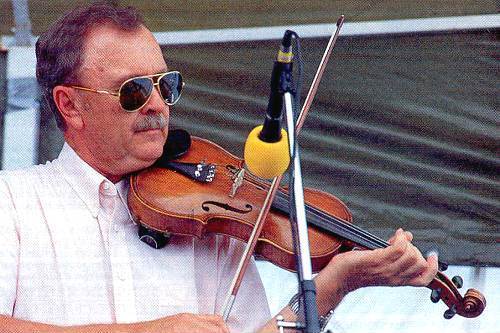
27 Clifford Hill playing at a Bluegrass Festival

28 Clifford with Joe Jeffries Group at Museum Lupardus Cabin
The Hill farm is in a beautiful valley setting, located on Shut In Creek. The home is a few hundred yards away from the creek nestled next to a hill. Clifford maintains the grounds with great skill. Here is a photo of Clifford standing near the creek with the home in the background one early spring day (photo 29).

29 Clifford Hill
Clifford’s siblings (Richard, Shirley, and Stanley) early on in their lives left Tuscumbia to pursue successful careers in Kansas City.
I have received some interesting correspondence regarding the story about movie theater owner Tom Edwards featured in the Progress Notes of September 12.
Lois Mace Webb (photo 30), of Stillwell, Kansas sent me this note:
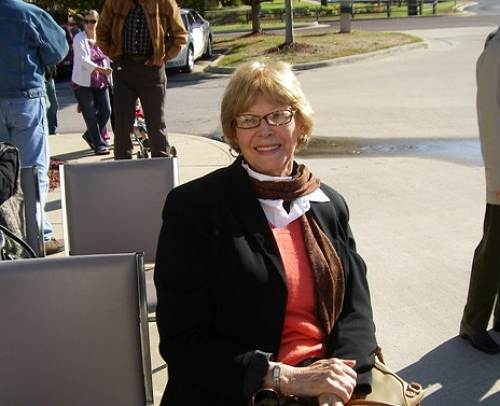
30 Lois Mace Webb
Joe:
About the Ozark Theatre/Tom Edwards commentary:
So grateful a copy of Tom's monthly mailing about movie news and musings came to light. Sure made me smile when I saw the format. Our family looked forward to reading his commentary as well as what went on at the movies. A Shirley Temple or Will Rogers movie was a must for us, and the evening drive from Brumley to Eldon was no small event in those days. Occasionally mom and dad went to a movie and Lee and I stayed at Grandma Mace's house. Lee and I did not begrudge our parents' night out because we got to stay at Grandma's, which meant her singing folk songs to us and playing games of some sort. And special foods.
Many remembrances emerge centered around the theatre in Eldon. One seemingly exciting event I recall from Tuscumbia, and felt slighted and non-understanding about why my parents would not let me go along, was that every Saturday night, John Klug took his stock truck filled with anyone who wanted to go to the show in Eldon. I remember seeing upwards of a dozen people, standing and holding on to the stock racks on the truck, laughing and having a good time as the truck left Tuscumbia, headed for the Ozark Theatre in Eldon. Looked like so much fun. But I never got to go. Nor did my world accommodate many Saturday afternoon westerns and serials -- just enough to know what people talked about and were eager to see the outcome of next week's drama.
Tom's chatter on the back of his showbill found an appreciative audience at our house too. Here's an example I remember and which I thought was brilliant humor at the time. Flood waters had covered the park area and Goose Bottom in Tuscumbia. Oliver and Ila Brockman's house was located in that area, terraced in earlier years in an effort to avoid water in the house, though the mighty Osage would thumb its nose at that attempt a few years later.
Anyway, Tom told of going to Tuscumbia to see the floodwaters, saw a hat bobbing in the water, and discovered Oliver Brockman under the hat, who explained that he intended to mow his lawn this week come hell or high water. Tom expressed a good natured humor and I remember him as a welcome character in the entire county.
Then, as fate would have it, I saw Tom with a degree of regularity as I grew up and entered the work-world. After finishing Business College in Kansas City right after THS, my first job was at the Kansas City distribution office of 20th Century Fox Film Corporation. I worked there for nearly eight years as executive secretary, until son David was nearing arrival. I have often said that 20th Century Fox raised me. In recent months I have rejoined the Movie Lunch Bunch group for a once a month get-together where the film industry is core topic. I belong to and support, though do not attend meetings, the Women of the Motion Picture Industry organization. Their international convention is in KC this year; I may attend few events.
This is to say that Tom came into our Fox office from time to time. The area was called Film Row, where all the studios maintained offices, booked film to exhibitors -- Tom was an exhibitor -- and from where film was shipped to the theatres. I treasure the time I spent there, and learned most of what I know about business while holding what was then called a fairly good job, at Fox.
I recall when the Fox film, “Glory Brigade” was made using Osage River scenes; you mentioned it recently and I was glad to see the pictures you displayed recently in your Progress Notes. I did not see Victor Mature while working at 20th Century; however, quite often when a new film was released, stars did make publicity tours including Kansas City. They came to our office and as executive secretary, my job included taking them for a tour of our facility and introducing them to the staff. I think I have a picture of me introducing Susan Hayward. Seems comical now. I recall her hair dresser staying within arm's reach of the star's hair, lest a hair get out of place. One of our office staff asked Susan, adorned in full length luxurious fur coat, if that was mink. Miss Hayward, in what I recall as a condescending tone, replied, no, it's sable. And we, the office staff laughed about that for a long time.
When The Robe came out, several of the performers included Kansas City on the publicity tour. The Giant was the main attraction, and unbeknownst to me till it happened, he stormed into the office, seized a "fair damsel" and acted as though he would kidnap her, after he carried her throughout the facility.
Yes, the fair damsel was yours truly. I was mortified, wondering in those days if the full skirt I wore covered me adequately. It did, I was assured, though too late to allay my concerns of the moment.
I have credited experiences at Fox with having taught me most of what I know about writing. Even though in later years, I earned a graduate degree in journalism from KU, my Fox boss forced me to write. He had no trouble with spoken English, however his Eastern European background left out unnecessary details like grammar. His manner of dictation after he read the mail went like this: tell this one yes; tell this one no; tell this old SOB to go to hell. And so it was my job to make him appear civil and adept on paper. We got along well. Another of my tasks that went to the NY office under his name was to ascertain weekly status of entertainment business in Kansas City. At one time I knew the seating capacity and attendance of every performing arts facility in the city. I can still estimate seating capacity with fair accuracy. And a perk of all the film distributor offices was a once a week screening of every new film. Each office had a private screening room and if Fox didn't have a new film that week, we'd borrow one from MGM, Paramount, or one of the other distributors. I appreciated my years at Fox, as well as continued connection in that world.
Thanks Lois.
Another comment was sent me by my cousin, Sandra Bear Shelton (photo 32):
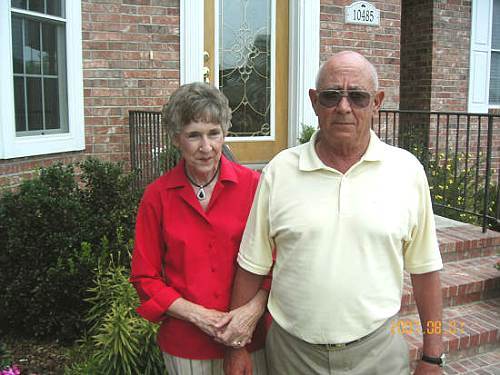
32 Sandra and David Shelton
Joe
I just now read your Progress Notes and it was nice to read about the Edwards. We bought our house on Newton Ave. from them when we moved to Eldon. Mom and Dad became acquainted with them and they were so nice to us 'newcomers'. Connie introduced mom to a lot of the local ladies and Tom helped dad get started playing golf, etc. They were just such warm and friendly people. Although I knew their daughter, Jodie, she was several years older than I was, so we never spent much time together. I didn't know their son at all. They were also good friends of the Sheltons. The town really missed them when they moved away after retiring. The MONKEY JUNGLE was quite a unique attraction and I never did know why Tom started that business, but it was a lot of fun. Did you ever go there? I used to take the boys there sometimes when they were having a birthday party. Kids always enjoyed it.
Anyhow, thanks for the memories, as they say.
Sandra
|
Thanks Sandra.
Here is a photo taken recently of the home on Newton Street which Tom Edwards sold to Sandra’s parents when they moved from Tuscumbia to Eldon (photo 33):
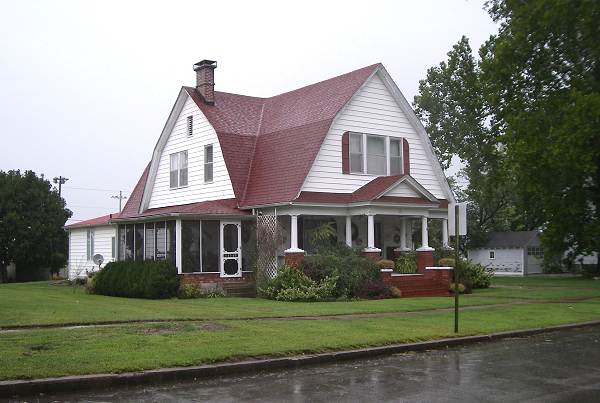
33 Tom Edwards Arthur Bear Home in Eldon
Recently, we were visited at the museum by Mike Wieneman and his niece, Carrie Eskay, and her son, David. Mike, originally from Eldon now living in Springfield, has supplied the museum with many historical photos through the years as well as historical narratives. Here is a photo of Mike, Carrie and David taken in front of the display of the movie, “Glory Brigade,” which was shown to the public at the museum a month ago (photo 34):
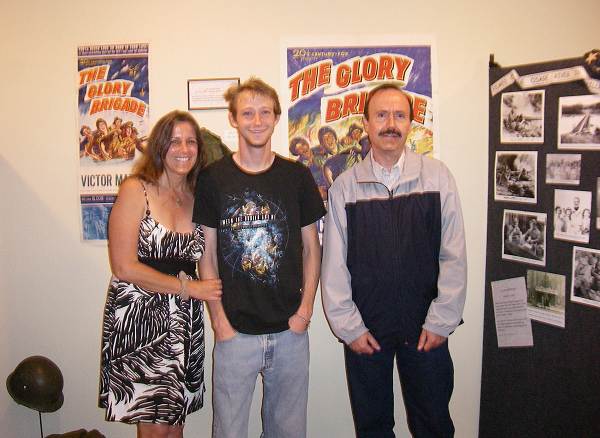
34 Carrie Eskay, David Eskay and Mike Wieneman
Mike donated all the show posters and photos in the display as well as provided us with the film itself. He has been one of our most valuable consultants.
Mike had not been to the museum since its expansion; however, when he lived in Miller County he was a very active member of the Historical Society. I gave him a tour and was amazed at his photographic memory. For just about every photo or portrait we had hanging on the walls, he not only could give the name of the person in the photo but also give a list of the names of that person’s antecedents and siblings. It was an amazing demonstration of memory I have never witnessed before! Here was a person who was a veritable walking demonstration of the words “photographic memory!”
That’s all for this week.
 Joe Pryor
Previous article links are in a dropdown menu at the top of all of the pages.
|

